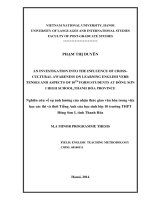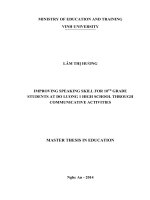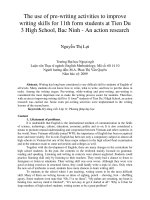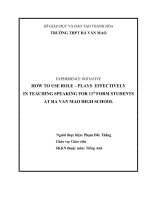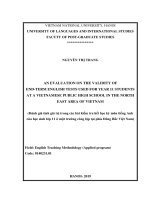Speaking tasks in English 10 (The Old Version) for the minority students at Yenbai Ethnic Boarding High school
Bạn đang xem bản rút gọn của tài liệu. Xem và tải ngay bản đầy đủ của tài liệu tại đây (112.89 KB, 5 trang )
speaking tasks in English 10 (The Old Version)
for the minority students at Yenbai Ethnic
Boarding High school
Nguyễn Thị Ngọc Hà
Trường Đại học Ngoại Ngữ
Luận văn ThS. Chuyên ngành: English Linguistics; Mã số: 60 22 15
Người hướng dẫn: Dr. Dương Thị Nụ
Năm bảo vệ: 2010
Keywords: Tiếng Anh; Kĩ năng nghe; Kĩ năng nói
Content:
PART I: INTRODUCTION
I.1. Rationale:
Vietnam is in the open-door period, moreover, from the November 2006, has become a
member of WTO, and so, English is getting more and more essential to Vietnamese people.
Being aware of this, Vietnamese students in general and students from Yen Bai Ethnic
Boarding High School have tried hard to study English better and better. However, English
teaching and learning have not been as effective as we expected. One of the reasons for those,
according to many teachers and students of English, is that the textbook “English 10” (the old
version), which is available for teaching and learning, is not always updated, realistic, and
appropriate to the context of an open-door policy and a market economy, even not interesting
enough to keep teachers and learners active during English lessons. Moreover, this textbook is
proved to lack flexibility, adaptation and linkage and reveals many shortcomings
As a teacher of English at Yen Bai Ethnic Boarding High School for 4 years, I find that
my students, especially the 10
th
grade ones, are quite bored with the tasks suggested in their
textbook “English 10”. Without adapted tasks proposed by teachers, English lessons may
become a burden for both teachers and students. Also, many of my colleagues have tried to adapt
tasks in the textbook to teach speaking and found that any adapted tasks always drew more
students’ attention and interest.
Furthermore, improving speaking skill for students from 10
th
grade proves essential
because most different ethnic students mind speaking English, usually keep quiet in speaking
lessons and their speaking ability is extremely poor.
For all those reasons, I have decided to carry out a study under the title: “Adapting
speaking tasks in English 10 (the old version) for the minority students at Yen Bai Ethnic
Boarding High School”
I.2. Aims of the study:
The study aims to:
- Investigate into the evaluation and attitudes of 10
th
grade students and teachers in Yen
Bai Ethnic Boarding High School(YEBHS) towards the speaking tasks based on “English 10”
(the old version).
- - find out techniques of adapting speaking tasks in order to make speaking teaching and
learning more effective and communicative.
I.3. Research questions:
- What are the teachers and students’ evaluation and evaluation an attitudes towards the
speaking tasks in “English 10” (the old version)?
- What techniques should be used to adapt of adapting speaking tasks in English 10 for
the 10 grade students in Yen Bai ethnic boarding high school?
I.4. Research method
In order to carry out this study, which is a survey research, a combination of different
data collection instruments are use to ensure the reliability of the collected information as well as
the accuracy and practicality of the study. To begin with, data was collected via from survey
questionnaires completed done by students and teachers in Yen Bai Ethnic Boarding High
School. The writer, then, worked with the data by combining different methods like analyzing,
synthesizing, comparing, etc. in order to draw out important findings.
In addition, five classes were chosen at random. Each class was asked to discuss five
questions in 15-20 minutes before giving the answers. The monitors then collected the answers
from the members in their classes and noted down the most common ones. These answers were
then reported to the writer in the post-discussion interview.
I.5. Scope of the study:
The study is limited to the data obtained from the survey questionnaires on the students
and teacher’s evaluation of the speaking tasks used for the 10
th
grade students on “English 10”
(the old version). Besides, they tended to find out their attitudes toward speaking task adaptation.
The responses from the participants were put as basis for suggested techniques of adapting
speaking tasks. Due to the limited time and the scope of a minor thesis, the questionnaires were
designed to mainly focus on evaluation. The study does not refer to how to teach speaking or
how to apply adapted tasks in teaching peaking. The aim of the study is to make speaking tasks
more practical and useful by creating more chances for students to communicate through adapted
tasks. By that way, students are more motivated to study and speaking topics are not separated
from real life contexts.
Conclusions and suggestions are mainly based on analysis data. However, with the
limited number of informants, the writer will only present her remarks, comments and
recommendations for appropriate techniques of adapting tasks for teaching speaking skill to the
10
th
grade students in YEBHS.
I.6. Organization of the study:
Part I: Introduction: This part provides an overview of the study with specific reference to
the rationale, the aims, scope, and the research method of the study.
Part II: Development includes three chapters, namely
Chapter I: The chapter explores relevant theoretical background for the thesis.
Chapter II: This chapter deals with the subjects, instruments and procedures of research
methods applied in the study.
Chapter III: This chapter is devoted to detailed description of the data analysis and a brief
discussion of the findings. From that, some recommendations on ways of adapting speaking
tasks are suggested in the form of giving samples.
Part III: Conclusion.
References
1. Anh, P. T. M. (2007). A study on applying communicative approach to speaking teaching and
learning at Tran Phu gifted high school. Unpublished M.A Thesis. Ha Noi National University
2. Anh, P. T. H. (2003). The application of communicative language teaching (CLT) in
teaching speaking to non English-major students in ministry of police: difficulties and
recommendations. Unpublished M.A Thesis. Ha Noi National University
3. Canh, L. V. (2004). Understanding Foreign Language Teaching Methodology: Ha Noi
National University Press.
4. Hiep, P. H. (2007). Communicative language teaching: unity within diversity. ELT Journal.
61/3
5. Hoa, N. T. M. (2006). The application of communicative language teaching (CLT) in teaching
speaking to non-English major students at Ha Noi University of business and management:
difficulties and recommendations. Unpublished M.A Thesis. Ha Noi National University.
6. Mulat, L. (2003). Teachers' attitudes towards communicative language teaching and practical
problems in its implementation. Asian EFL Journal.
7. Nunan, D. (1991). Language Teaching Methodology. New York: Prentice Hall
8. Richards, J. C. (2001). Communicative Language Teaching Today. ELT Journal.
9. Richards, R.C. & Rodgers, T.S. (1986). Approaches and Methods in Language Teaching. New
York: Cambridge University Press.
10. Suzane Bacon (2009). Communicative Language Teaching. Retrieved 10
th
December, 2009,
from
11. Trang, N. T. N. (2007). A consideration of how the communicative approach may be used to
teach speaking to the third year students at Military Technical Academy. Unpublished M.A
Thesis. Ha Noi National University
12. Harmer,J. 1987. Teaching and Learning Grammar. Longman Group UK Limited.
13. Leech, G & Svartvick, J. 1975. A Communicative Grammar of English. London: Longman.
14. Larsen Freeman, D & Long. M. 1991. An Introduction To Second Language Acquisition.
Longman.
15. Hoan, P. K. (2004). Tieng Anh 10. Hanoi: Education Publishing House.
16. Website:
H:\CLT\Characteristics of CLT.htm
H:\CLT\Communicative language teaching- Wikipedia, the free encyclopedia




